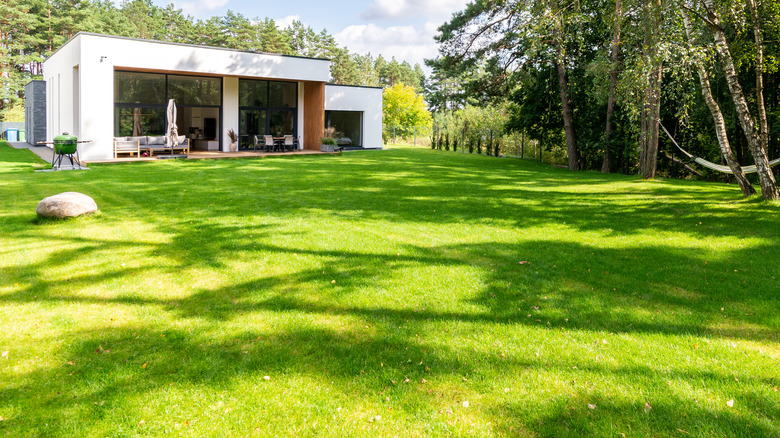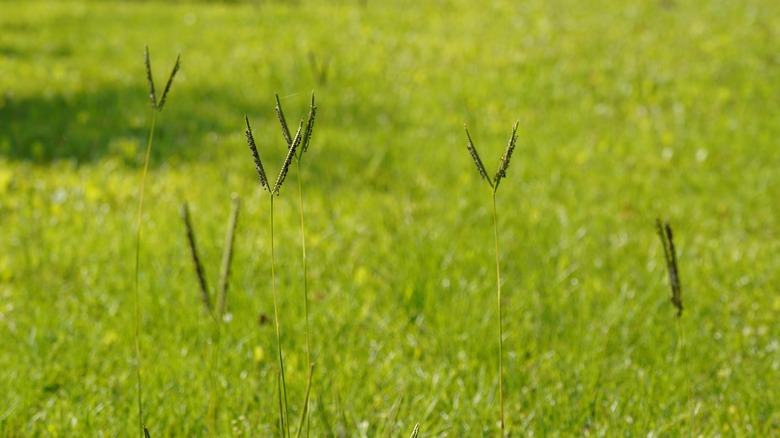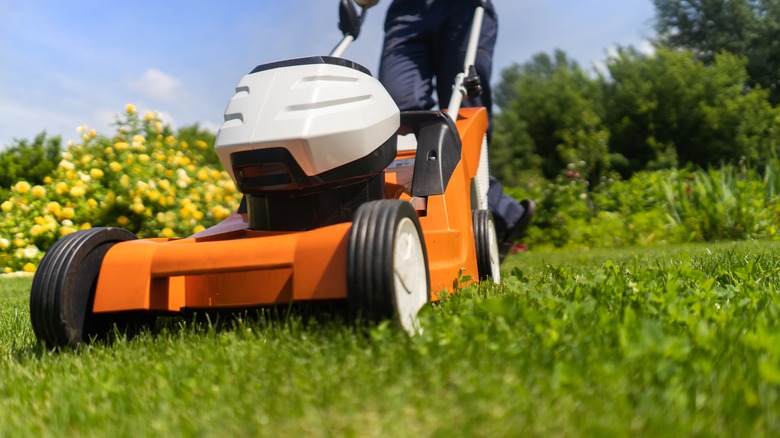The Affordable, Drought-Resistant Grass You'll Want To Know About
Your ideal luxe lawn is probably so green that it could move van Gogh to render another "Clumps of Grass" painting. But, if you're faced with infertile soils, drought stress, and brown thumbs, a green carpet seems like a distant dream. Not anymore! Seeding or sodding bahiagrass (Paspalum notatum), a coarsely textured turf with under 12-inch-long pointed leaves that sometimes appear folded, can rescue your nutrient-deficient, sunny yard. Hardy from zones 8 to 10, it's one of the best grasses to handle extreme heat, especially its Argentine variety, renowned for its relatively darker green tones and broad leaves despite subpar winter hardiness.
A South American native, bahiagrass was initially introduced as a forage or hay crop in southern state pastures. Since then, it has become popular among price-sensitive gardeners who adore its easy maintenance and high pest and disease resistance. When left unmowed, this turf grows almost 1 foot high, giving way to its characteristic V-shaped pair of racemes with a few spikelets mixed in, which many find unattractive. So, unless you share Albrecht Dürer's sensibilities of a "Great Piece of Turf," including a heady mass of grass, roots, and weeds, be prepared to trim the lawn frequently. This should also take care of mole crickets that sometimes latch onto the grass. Bahiagrass also exhibits poor tolerance for salt and high foot traffic.
Pros of growing Bahiagrass
Bahiagrass thrives in nutrient-deficient, sandy, and acidic soils, where most other warm-season grasses struggle to establish themselves. Usually mistaken for stolons, given their above ground-level presence, rhizomes are responsible for these tufts spreading aggressively and forming a dense carpet, making them great for immediate groundcover. Although seeded shallowly between ½ and ¼-inch depth to spur quick emergence, bahiagrasses develop deep, extensive root systems with humongous food storage reserves. As a result, they easily withstand drought conditions and have become ubiquitous in yards lacking irrigation systems or located in arid climates. Such entrenched rooting enables erosion control, too.
However, when exposed to incessantly dry conditions, these grasses become dormant, regaining their green selves only after they've been rained on or soaked in water. They're also low maintenance and unfussy about fertilization, justifying their presence in municipally owned common areas and along roadsides and highways. Although sharing a penchant for full sun, bahiagrasses can tolerate some shade, unlike bermudagrasses. Moreover, bahiagrass is inexpensive, with its sod priced on average between $0.20 and $0.40 per square foot compared to St. Augustine and Zoysia grasses, which can cost up to $0.80 per square foot in extreme cases. Further, you'll save more money by starting with grass seeds.
Drawbacks of seeding Bahiagrass
Although sowing seeds saves costs and labor, they germinate at different rates, leaving your lawn with unevenly growing blades and patches. This is because bahia seeds are covered in a waxy coating, which impedes their water uptake. But, since the coating's durability depends on seed storage and current soil conditions, you can achieve better performance by using seeds that have been stored for at least a year or scarified seeds, as they've been treated chemically to augment sprouting. However, it may take the bahiagrass up to 3 years to create an impenetrable carpet, making the lawn susceptible to weeds, such as crabgrasses and crowsfoot grasses, during growth.
Although bahiagrass thrives in most soils, it prefers pH levels under 6.5. Otherwise, like with alkaline soils, it may turn yellow due to the shortage of iron, necessitating treatment with ferrous sulfate. Similarly, it isn't suited to fertile soils, as the ready availability of nutrients turns it into a prolific spreader. So, skip planting bahiagrass if you want to overseed with other warm-season grasses or plant flowering shrubs.
Additionally, bahiagrass requires frequent mowing (weekly or fortnightly) to maintain its height and stimulate root growth. But, as its blades are rough and sturdy, you'll be limited to using high-power rotary mowers. The higher frequency may dull the blades sooner, which can make the grass prone to tearing and contracting diseases. To prevent this, routinely sharpen your mower blades. Keep up with its maintenance, and bahiagrass could be an excellent choice for your nutrient-poor lawn.


